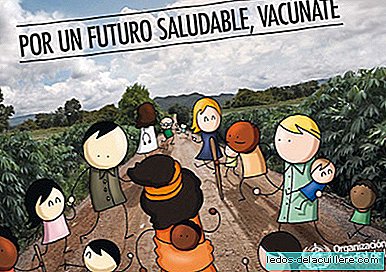
The World Health Organization has just published ten facts about child health in the world, reminding us that 7.6 million children under the age of five die each year (more than 900 children every hour), but most of them could survive and grow if they had access to simple, low-cost interventions.
These ten data refer to topics that often interest us in the blog, such as birth care, premature babies, nutrition, the importance of breastfeeding, midwives, the most devastating diseases ... and are very enlightening for get an idea of what it means be born and be a child in other countries not so developed.
The risk of death is higher in the first month of the child's life. Safe delivery and effective neonatal care are essential in the first month of life. Premature birth, asphyxiation of childbirth and infections cause most of the deaths of newborns. From the month until 5 years of age, the main causes of death are pneumonia, diarrheal diseases and malaria. Malnutrition is a contributing factor in more than a third of these child deaths.
Three million children die each year before their first birthday. The life of the newborn is fragile. The health hazards of newborns can be reduced by: quality care during pregnancy; a safe delivery attended by skilled midwifery assistants; and good neonatal care: immediate attention to breathing and heat, hygienic manipulation of the umbilical cord and skin, and exclusively breastfeeding.
Pneumonia is the leading cause of death in children under five years old. Almost three quarters of the 154 million cases of pneumonia that occur each year are concentrated in only 15 countries. Combating the main risk factors through immunization, exclusive breastfeeding and good nutrition is essential to prevent this disease.
Diarrheal diseases They are one of the leading causes of illness and death in children in developing countries. Exclusive breastfeeding helps prevent diarrheal diseases in young children. The treatment of children afflicted with one of these diseases with oral rehydration salts (ORS) and zinc is safe and cost effective, and prevents death. In the last 25 years more than 50 million children around the world have saved their lives thanks to the SRO.
Every 45 seconds an African child dies due to malaria. Malaria is the leading cause of death of children under 5 in the African Region. Mosquito nets treated with insecticides prevent transmission and increase children's survival. Fast antimalarial treatment also saves lives.
More than 90% of HIV-infected children They become infected by mother-to-child transmission. This form of transmission can be prevented through the use of antiretrovirals, coupled with safer obstetric and food practices. Approximately 2.3 million children under the age of 5 are infected with HIV and another 1400 are infected every day. If no treatment is given, more than half of the infected children die before the age of 2. Antiretroviral treatment of these children greatly improves survival rates and quality of life.
There are about 20 million children under five with severe malnutrition in the world. Severe malnutrition makes children more vulnerable to disease and death. Most of these children can be treated effectively at home with therapeutic foods ready for consumption. Globally, it is estimated that, in 2010, 171 million children under the age of five suffered stunted growth and 104 million had underweight. Optimal breastfeeding and complementary feeding practices help prevent malnutrition and can save the lives of about one million children.
Three quarters of child deaths They are registered in Africa and Southeast Asia. The child survival rate has large geographical variations. In different countries, mortality is higher in rural areas and in the poorest families with a lower educational level.
Approximately two thirds of child deaths are preventable. They can be prevented if there is access to practical interventions of low cost and effective primary care up to 5 years of age. Child health is improving, but there are still major obstacles to achieving the goal of reducing global mortality. To improve access to care and prevention, stronger health systems are essential.
The increase in investment is key. Increased investment will help reduce the under-five mortality rate of two-thirds between 1990 and 2015 (Fourth Millennium Development Goal). To achieve this goal, it is necessary that public and private partners cover the existing financial deficit of approximately 50,000 million dollars. The creation of the Commission on Information and Accountability, the Global Strategy for the Health of Women and Children and the announcement in recent months of several large funding pledges from bilateral donors represent important steps in the right direction .
WHO, together with other organizations involved with children, is trying to improve children's health by helping countries that need it most to provide integrated and effective health care that goes from healthy pregnancy to childbirth and the provision of child health care to The five years.
The investment in solid health systems is fundamental for the provision of this preventive care, although it is not easy in the times that run and in a context in which we seem to want to forget or underestimate these ten facts about child health in the world.












